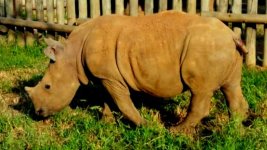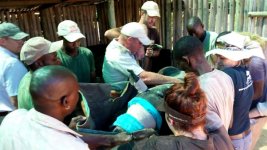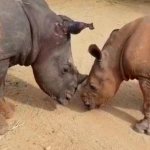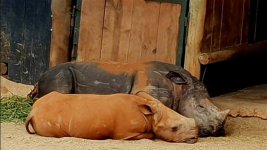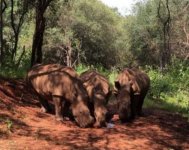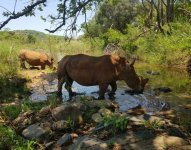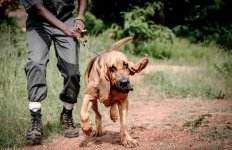OK, so after my little emotional outburst above, here is an update of happenings at the Sanctuary for February
Meet Lazuli, our latest arrival
View attachment 322447
On the evening of the 14th February 2019, Care for Wild Rhino Sanctuary was notified about a calf that had been orphaned the previous night (13th February 2019) on a private game reserve adjacent to the Kruger National Park. Three rhino cows were poached at a waterhole, one of which had a young male calf at her side.
The young rhino bull was located around 4pm on the 14th February 2019 and seen to have been injured by hyenas. Due to the size of the calf, a helicopter was not going to be able to transport the calf to safety. The rescue team needed to devise another plan while the rangers kept an eye on the orphaned rhino. A trailer was made available and sent to the location. Having gotten lost in the unforgiving bush, the trailer eventually arrived at the calf around 8:30pm.
Veterinarian Dr. Joel Alves, darted the young calf and rescued him from the bush. The calf was placed on a drip and basic wound care was given and he was loaded onto the trailer and begun his journey to safety. Unfortunately, due to the harsh nature of the bush, the trailer suffered damage to the tire, rendering it unsafe to continue. Being the middle of the night, the team had very few options.
Fortunately, a pick up truck with a canopy was made available to assist in the rescue of the orphaned calf. This less-than-ideal option was the only option the team had, as the life of the orphaned calf was at stake. The rescue team moved the injured calf across into the back of the canopied vehicle. Cushions and blankets from the nearby camp were used to make the journey as comfortable as possible. The team finally made their way to Care for Wild Rhino Sanctuary where they arrived at 02:54am in the morning.
View attachment 322448
Upon arrival, the calf was moved from the vehicle into the baby rhino crate at the Intensive Care Unit. The orphan’s wounds were cleaned and treatment begun. The calf’s vital signs were monitored as his blood glucose levels on arrival were very low. The orphaned rhino began learning to drink from a bottle just a few hours after his arrival, and by the next day he was drinking his milk well.
Lazuli, as he is now named, has a very special meaning. Lazuli means royalty and honor, gods and power, spirit and vision.
Having survived being viciously attacked and wounded by hyenas, Lazuli’s wounds needed to be treated thoroughly. On the 19th February 2019, Dr. Ferreira du Plessis and Dr. Albertus Coetzee sedated Lazuli and tended to his wounds surgically. Some shredded tissue had to be removed and many sutures applied. The Care for Wild Rhino Sanctuary team continues to monitor Lazuli’s progress and we are happy to report that his condition continues to improve.
On the 21st February 2019, Lazuli was introduced to baby Ribbon for the first time. The moment was simply magical. The two orphans nuzzled each other, and became the friends they have been waiting for, in an instance! We are happy to report that the two orphaned rhinos have since been moved out of the ICU and now spend their days playing, napping and eating together in one of the larger bomas at the main holding facility.
View attachment 322449
View attachment 322450
An Update on the latest youngsters that were released
The group of young orphaned rhinos that were reintroduced back into the wild within the Care for Wild Rhino Stronghold last month are doing exceptionally well. The orphans have settled in to their new bush home and can be seen enjoying their life to the full.
The group of orphans enjoy playing in mudbaths throughout the reserve and near the river. They are growing in size with all the green grass that envelops them. They wander the rolling fields and hills, exploring and seeking new adventures as their confidence builds.
We are proud to say that little orphaned rhino, Lilli, has adapted excellently to the bush as well. She continues to be fed her milk in the bush, daily, and remains the social butterfly of the released rhinos, a free spirit.
View attachment 322451
View attachment 322452
CFW's K9 unit
Care for Wild Rhino Sanctuary is protected on various levels by our Anti-Poaching Units, one of which is the K9 Unit. The K9 Unit, which includes the dogs and their handlers, patrol the main holding facility, day and night, as well as the Rhino Stronghold, where many of the orphaned rhinos have been reintroduced into the wild.
We are proud to say that we have employed two additional K9 Unit dog handlers that have been trained to work with the dogs at the sanctuary. Dog training is an on going happening at CFW and two of our dogs have recently completed a refresher course. They are all eager, willing and alert. Here is a pic of Diesel on the scent.
View attachment 322454

